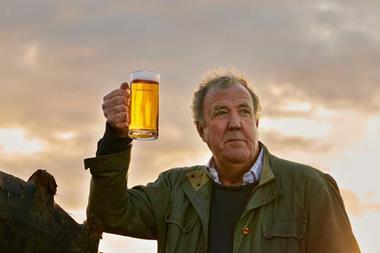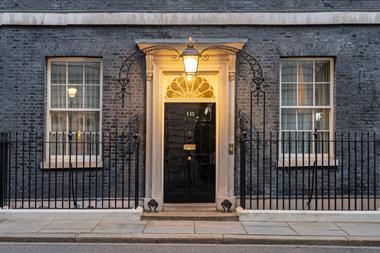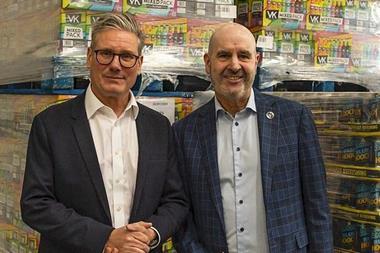As Mel Marriott prepares to unveil the fifth Darwin & Wallace pub, this time at the new Battersea Power Station site, she talks to Mel Flaherty about how the area provides the style for each outlet and the potential for expansion, especially outside London
Mel Marriott is feeling “the right degree of anxiety” about her next venture. When it opens next spring, the fifth site in her Darwin & Wallace (D&W) pub collection will not only face the pressures presented to any brand new outlet, it will be part of something that hopes to finally lay to rest the ghosts of a theme park that never materialised, a famous visit from a hard-hatted Margaret Thatcher and various overseas investors with unrealised ambitions.
As the only pub in the first phase of the redevelopment of the iconic Battersea Power Station site (specifically within the Circus West leisure scheme), No 29 has a lot of expectations to meet.
The firm was chosen from an initial round of 18 interested parties after a very thorough and arduous selection process. Marriott’s confidence in the D&W concept and the work put into the pitch meant she was not entirely surprised it was picked, even though, from the outside, it may not seem the obvious choice.
Unlike the new-build, new destination Battersea unit, all four pubs in the existing D&W portfolio are in London villages and in well-established, older buildings. The intention is for the whole power station area to become a go-to location in its own right, helped by the opening of a new Tube station, but there will be a lot of development taking place for a number of years to come. And, of course, the building will be brand new and, at 10,000sq ft, it will also be significantly bigger than D&W’s current largest site, the 7,000sq ft No 1 Duke Street in Richmond, south-west London.
Marriott is looking forward to the challenge and says she is ready for it:
“I am really managing expectations because it is going to take a while to build up that new community. But in terms of pounds spent per square foot, it is comparable to the others and with our attention to design, it will not just be a big glass box, it will be a modern building with character and a wonderful backdrop – I am comfortable in our ability to create that.”
Detail behind the success
No 29 will have a ground and lower ground floor, with the lower bar offering a flexible space that can be used for private hire. A screening room will also be incorporated and the venue will collaborate with a local art gallery, acting as an outpost for its works.
Backed by Imbiba, the specialist investment partnership, D&W is not at liberty to give out figures, but Marriott concedes the investment in the Battersea project is sizeable. Despite the prestige of the project, she has no intention of “throwing the kitchen sink at it”, laughing that her Yorkshire roots (which are not all discernible from her accent) give her no option but to seek out the best value for her spend. Not that she is scrimping – the attention to detail in all the D&W venues is quite astonishing and is what lies at the heart of the brand’s success.
From a standing start just three and a half years ago, D&W has grown into a £10m-plus turnover business with some 200 employees. It is well ahead of where Marriott expected it to be by now – the size of the business has doubled in the past year alone following the openings of No 1 Duke Street in November 2015 and No 197 Chiswick Fire Station in April.
The pubs are all beautifully designed to be very much of their area, to the extent that D&W already has a fairly long list of awards received for the look of its venues (Duke Street was also recently named Best Bar & Pub in Richmond by Time Out).
Many of the fixtures and furnishings are made by young, pioneering local artisans, which Marriott says helps root them further to their locale (the decision to name the sites by their street address was made to reinforce that neighbourhood feel and is the reason the group’s generous loyalty scheme and newsletter is called ‘The Address’) and gives them an individual feel. It is not the easiest way to make pubs, but it is of utmost important to Marriott and the brand:
“I think the look of a place is a really important part of socialising in London. Many people don’t have the space to entertain in their own homes so they want to take their friends to somewhere that reflects their own goals and aspirations.”
Avoiding homogeneous sites
The starting point for the idea for D&W was the reinvention of the gastropub. Marriott felt they had generally become “too cookie-cutter with dark colours in Farrow & Ball paint, and the food was lacking”. She also felt they were missing opportunities to provide what customers want at different times of the day.
She spent a year creating a ‘look book’ that would communicate her vision for everything from food to light fittings in her ideal pub. There is common menu, changed quarterly, across the sites, but they all have a unique feel. The focus on the minutiae extends to everything from the quality of the coffee offer, fresh flowers throughout the venues, scratch-cooked food, DJ-selected music playlists, mixologist-designed cocktails, an interesting range of wines and beers – the list is exhaustive and to maintain that level of quality must be exhausting. She says the understanding of that vision by her operations manager Jessica Closs and executive chef Simon Duff, who have been with her from day one, plus the support of her finance director Paul Trimmer, make it possible.
She is constantly in the business, talking to customers to ensure outlets meet their needs. On weekdays, many people use the pubs as somewhere to work; there are live DJs on Fridays and Saturdays and breakfast/brunch is 17% of overall food sales.
Marriott’s passion for the perfect pub stems from her involvement with the then Bass-owned All Bar One brand, right at the start, which she still admires as “game-changing”.
Despite spending the four years of her economics degree at Middlesex University saying she was going to work in the City, Marriott was drawn to the hospitality sector thanks to her summer job at Oscar’s Wine Bar in York. When the opportunity to run that million-pound business and its staff of 20 came up, she leapt at the chance and never looked back – in fact, she swears she is “lucky enough to have never had a job that I didn’t absolutely love”.
Opportunity in the sun
Marriott was in her mid-20s when her uncle, who had a long career in drinks retailing in London, asked her to go to
Lanzarote to help run his bar. She did this for three years before coming back to England and chancing upon an article about All Bar One’s first site in Sutton, Surrey, that struck a chord for her.
“I thought that if I had my own bar, it would be just like that – the design was important, the food cooked from scratch. It was a real climate change in what bar retailing was about – a recognition by the market of females and of wine,” she recalls.
She was so excited by the idea that she wrote to the company and ended up as the general manager of its first site outside London, in Leeds. She quickly became area manager and ended up moving to London. After a while, her inner entrepreneur drew her out of big company culture and back to the sunshine to run a boutique hotel in southern Spain, where she loved being hands on again.
When Marriott came back to London, she opened a café in south-west London and then took some time out to concentrate on her two young sons.
The idea to create her own perfect pub kept niggling away at her though. Happily, getting Imbiba to invest to make it happen “was not a hard sell”, thanks to the combination of her look book, her experience and the clarity of her vision, plus the fact that it had already enjoyed success with the Drake & Morgan pub group.
Like all entrepreneurs, Marriott lives and breathes the business. She is not joking
when she refers to it as her “third baby” so, even though she anticipates that Imbiba will be looking to realise its investment within two years, she cannot see herself doing anything else in the foreseeable future.
A group website is imminent – even though Marriott set up the business with the plan and necessary systems in place to make it a multi-site operation – she was wary of trumpeting the pubs as a collection until now. She is always constantly looking at different ways of promoting the pubs, whether by working with local businesses, such as a recent collaboration to showcase jewellery at No 1 Duke Street, or inventive marketing initiatives with drinks suppliers.
Beyond opening Battersea and the day-to-day evolution of the business, Marriott has an eye on expansion. She is aware of the possibility of diluting the “classiness” of the brand as it grows, but has recently created a new group training role to develop staff internally as part of her strategy to avoid that and is already well-practised at seeking external help to deliver high standards in areas she is not an expert in herself, such as cocktails and music. She is discussing heads of terms for a potential site in west London and sees opportunities – not just in London villages: “Would what we are doing here be as applicable in Leeds and Manchester? Absolutely! We are not creating a London-specific brand of hospitality.”










































